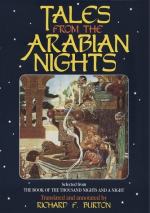[FN#10] Lane (iii. 83) would make this a corruption of the Hindu “Maharaj"=great Rajah: but it is the name of the great autumnal fete of the Guebres; a term composed of two good old Persian words “Mihr” (the sun, whence “Mithras”) and “jan"=life. As will presently appear, in the days of the Just King Anushirwan, the Persians possessed Southern Arabia and East Afica south of Cape Guardafui (Jird Hafun). On the other hand, supposing the word to be a corruption of Maharaj, Sindbad may allude to the famous Narsinga kingdom in Mid-south India whose capital was Vijaya-nagar; or to any great Indian Rajah even he of Kachch (Cutch), famous in Moslem story as the Balhara (Ballaba Rais, who founded the Ballabhi era; or the Zamorin of Camoens, the Samdry Rajah of Malabar). For Mahrage, or Mihrage, see Renaudot’s “Two Mohammedan Travellers of the Ninth Century.” In the account of Ceylon by Wolf (English Transl. p. 168) it adjoins the “Ilhas de Cavalos” (of wild horses) to which the Dutch merchants sent their brood-mares. Sir W. Jones (Description of Asia, chapt. ii.) makes the Arabian island Soborma or Mahraj=Borneo.
[FN#11] Arab. “Sais”; the well-known Anglo-Indian word for a groom or rather a “horse-keeper.”
[FN#12] Arab. “Darakah”; whence our word.
[FN#13] The myth of mares being impregnated by the wind was known to the Classics of Europe; and the “sea-stallion” may have arisen from the Arab practice of picketing mare asses to be covered by the wild ass. Colonel J. D. Watson of the Bombay Army suggests to me that Sindbad was wrecked at the mouth of the Ran of Kachch (Cutch) and was carried in a boat to one of the Islands there formed during the rains and where the wild ass (Equus Onager, Khar-gadh, in Pers. Gor-khar) still breeds. This would explain the “stallions of the sea” and we find traces of the ass blood in the true Kathiawar horse, with his dun colour, barred legs and dorsal stripe.
[FN#14] The second or warrior caste (Kshatriya), popularly supposed to have been annihilated by Battle-axe Rama (Parashu Rama); but several tribes of Rajputs and other races claim the honourable genealogy. Colonel Watson would explain the word by “Shakhayat” or noble Kathis (Kathiawar-men), or by “Shikari,” the professional hunter here acting as stable-groom.
[FN#15] In Bul. Edit. “Kabil.” Lane (iii. 88) supposes it to be the “Bartail” of Al-Kazwini near Borneo and quotes the Spaniard B. L. de Argensola (History of the Moluccas), who places near Banda a desert island, Poelsatton, infamous for cries, whistlings, roarings and dreadful apparitions, suggesting that it was peopled by devils (Stevens, vol. i., p. 168).
[FN#16] Some texts substitute for this last phrase, “And the sailors say that Al-Dajjal is there.” He is a manner of Moslem Antichrist, the Man of Sin per excellentiam, who will come in the latter days and lay waste the earth, leading 70,000 Jews, till encountered and slain by Jesus at the gate of Lud. (Sale’s Essay, sect. 4.)




